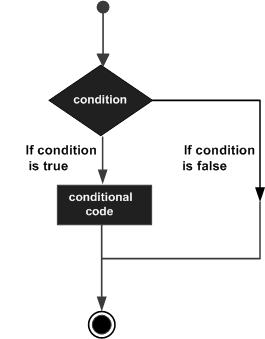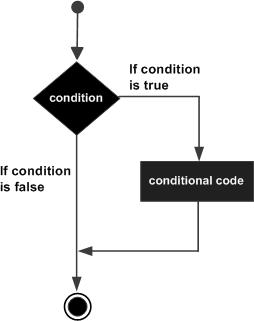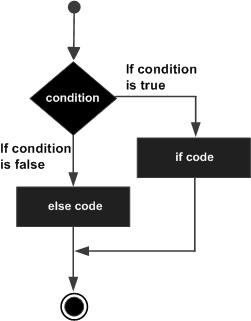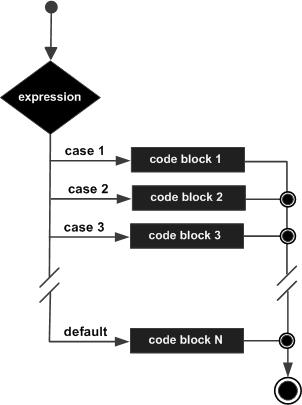初識Tcl(四):Tcl 決策
目錄
Tcl決策
決策結構需要程式設計師指定的一個或多個條件進行評估,或由程式進行測試,如果條件被確定為真以及一條或多條語句,任選的其它語句,如果條件被確定為假則被執行。
以下是在大多數程式語言中找到的典型決策結構的一般形式:
TCL語言使用expr內部命令,因此它為我們宣告使用expr的宣告不是必需的。
TCL語言提供了以下幾種型別的決策語句。
| 語名 | 描述 |
|---|---|
| if語句 | if語句包含一個布林表示式後跟一個或多個語句。 |
| if...else語句 | if語句可以跟著一個可選的else語句,當else執行時,布林表示式是假。 |
| 內嵌if語句 | 可以使用一個if 或else if 裡面再宣告 if 或 else if 語句(S)。 |
| switch語句 | switch語句可以讓一個變數對值列表相等進行測試。 |
| 內嵌switch語句 | 可以使用一個switch語句在另一個switch語句中。 |
? : 操作符
我們已經覆蓋條件操作符 ? :在前面的章節中可以用它來代替 if ... else語句。以下是它的一般形式:
Exp1 ? Exp2 : Exp3;
計算Exp1,Exp2和Exp3表示式。注意使用和放置。
a的值?表達是確定這樣:Exp1計算評估。如果是真的,那麼Exp2後進行評估計算,併成為整個的值?表示式。如果計算Exp1是假的,那麼Exp3計算它的值變為表示式的值。一個例子如下所示。
#!/usr/bin/tclsh
set a 10;
set b [expr $a == 1 ? 20: 30]
puts "Value of b is $b\n"
set b [expr $a == 10 ? 20: 30]
puts "Value of b is $b\n"
當編譯和執行上面的程式,將會產生以下結果:
Value of b is 30
Value of b is 20Tcl if語句
if語句包含一個布林表示式後跟一個或多個語句。
語法
Tcl語言的if語句的語法是:
if {boolean_expression} {
# statement(s) will execute if the boolean expression is true
}
如果程式碼里布爾表示式的值為真,那麼if語句塊將被執行。如果 if 語句的結束(右大括號後)布林表示式的值為false,那麼第一套程式碼會被執行。
TCL語言使用expr內部命令,因此它不是明確地使用expr語句宣告所需的。
流程圖
示例
#!/usr/bin/tclsh
set a 10
#check the boolean condition using if statement
if { $a < 20 } {
# if condition is true then print the following
puts "a is less than 20"
}
puts "value of a is : $a"
當上述程式碼被編譯和執行時,它產生了以下結果:
a is less than 20
value of a is : 10Tcl if...else 語句
if語句可以跟著一個可選的else語句,else語句塊執行時,布林表示式是假的。
語法
在Tcl語言的if ... else語句的語法是:
if {boolean_expression} {
# statement(s) will execute if the boolean expression is true
} else {
# statement(s) will execute if the boolean expression is false
}如果布林表示式的值為true,那麼if程式碼塊將被執行,否則else塊將被執行。
TCL語言使用expr內部命令,因此它不是明確地使用expr語句所需的。
流程圖
示例
#!/usr/bin/tclsh
set a 100
#check the boolean condition
if {$a < 20 } {
#if condition is true then print the following
puts "a is less than 20"
} else {
#if condition is false then print the following
puts "a is not less than 20"
}
puts "value of a is : $a"當上述程式碼被編譯和執行時,它產生了以下結果:
a is not less than 20;
value of a is : 100if...else if...else 語句
if語句可以跟著一個可選的else if ... else語句,使用單個if 測試各種條件if...else if 宣告是非常有用的。
當使用if , else if , else語句有幾點要記住:
-
一個if可以有零或一個else,它必須跟在else if之後。
-
一個if語句可以有零到多個else if,並且它們必須在else之前。
-
一旦一個 else if 成功,任何剩餘else if 或else 不會再被測試。
語法
Tcl語言的 if...else if...else語句的語法是:
if {boolean_expression 1} {
# Executes when the boolean expression 1 is true
} elseif {boolean_expression 2} {
# Executes when the boolean expression 2 is true
} elseif {boolean_expression 3} {
# Executes when the boolean expression 3 is true
} else {
# executes when the none of the above condition is true
}示例
#!/usr/bin/tclsh
set a 100
#check the boolean condition
if { $a == 10 } {
# if condition is true then print the following
puts "Value of a is 10"
} elseif { $a == 20 } {
# if else if condition is true
puts "Value of a is 20"
} elseif { $a == 30 } {
# if else if condition is true
puts "Value of a is 30"
} else {
# if none of the conditions is true
puts "None of the values is matching"
}
puts "Exact value of a is: $a"當上述程式碼被編譯和執行時,它產生了以下結果:
None of the values is matching
Exact value of a is: 100Tcl 巢狀if語句
Tcl巢狀if-else語句它始終是合法的,這意味著可以使用一個 if 或 else if 在另一 if 或 else if 宣告中。
語法
巢狀if語句的語法如下:
if { boolean_expression 1 } {
# Executes when the boolean expression 1 is true
if {boolean_expression 2} {
# Executes when the boolean expression 2 is true
}
}可以巢狀else if...else 在類似巢狀if語句的方式。
示例
#!/usr/bin/tclsh
set a 100
set b 200
# check the boolean condition
if { $a == 100 } {
# if condition is true then check the following
if { $b == 200 } {
#if condition is true then print the following
puts "Value of a is 100 and b is 200"
}
}
puts "Exact value of a is : $a"
puts "Exact value of b is : $b"當上述程式碼被編譯和執行時,它產生了以下結果:
Value of a is 100 and b is 200
Exact value of a is : 100
Exact value of b is : 200Tcl Switch語句
switch語句可以讓一個變數值的列表進行相等測試。每個值被稱為一個的情況(case),該變數被接通檢查每個switch case。
語法
Tcl語言未加引號的switch語句的語法如下:
switch switchingString matchString1 {body1} matchString2 {body2} ... matchStringn {bodyn}Tcl語言未加引號的switch語句的語法如下:
switch switchingString {
matchString1 {
body1
}
matchString2 {
body2
}
...
matchStringn {
bodyn
}
}以下規則適用於switch語句:
-
在switch語句中使用的switchingString通過比較matchString使用在不同塊之間。
-
在一個switch內可以任何數量matchString塊。
-
switch語句可以具有可選預設塊,其中必須出現在開關的末尾。預設情況下,可用於執行任務時沒有一個case是真實的。
流程圖
例如:未加引號版本
#!/usr/bin/tclsh
set grade C;
switch $grade A { puts "Well done!" } B { puts "Excellent!" } C { puts "You passed!" } F { puts "Better try again" } default { puts "Invalid grade" }
puts "Your grade is $grade"當上述程式碼被編譯和執行時,它產生了以下結果:
You passed!
Your grade is C例如:引用版本
#!/usr/bin/tclsh
set grade B;
switch $grade {
A {
puts "Well done!"
}
B {
puts "Excellent!"
}
C {
puts "You passed!"
}
F {
puts "Better try again"
}
default {
puts "Invalid grade"
}
}
puts "Your grade is $grade"當上述程式碼被編譯和執行時,它產生了以下結果:
Well done
Your grade is BTcl巢狀Switch語句
有可能有一個switch作為外開關的語句序列的一部分。即使在內外switch case 的常數包含共同的值,如果沒有衝突將出現。
語法
巢狀switch語句的語法如下:
switch switchingString {
matchString1 {
body1
switch switchingString {
matchString1 {
body1
}
matchString2 {
body2
}
...
matchStringn {
bodyn
}
}
}
matchString2 {
body2
}
...
matchStringn {
bodyn
}
}示例
#!/usr/bin/tclsh
set a 100
set b 200
switch $a {
100 {
puts "This is part of outer switch"
switch $b {
200 {
puts "This is part of inner switch!"
}
}
}
}
puts "Exact value of a is : $a"
puts "Exact value of a is : $b"當上述程式碼被編譯和執行時,它產生了以下結果:
This is part of outer switch
This is part of inner switch!
Exact value of a is : 100
Exact value of a is : 200




